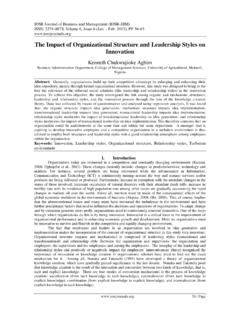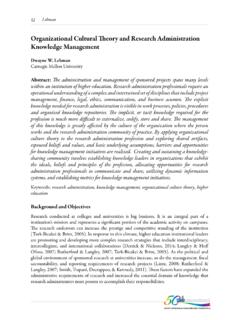Transcription of ORGANIZATIONAL ASSESSMENT: EFFECTIVENESS VS. …
1 Social Transformations in Contemporary Society'', 2013 (1). ISSN 2345-0126 (online). ORGANIZATIONAL ASSESSMENT: EFFECTIVENESS VS. EFFICIENCY. Ilona Bartu evi ien . Mykolo Romerio universitetas, Lithuania Evelina akalyt . Mykolas Romeris University, Lithuania Abstract Purpose ORGANIZATIONAL assessment has always been the key element of the discussion among scientists as well as business people. While managers are striving for better performance results, scientists are reaching for best ways to evaluate the organization. One of the most common ways to assess the performance of the entity is to measure the EFFECTIVENESS or the efficiency of the organization.
2 Those two concepts might look synonymous, yet as the findings revealed they have a distinct meaning. The purpose of this article is to reveal those differences and explore ORGANIZATIONAL assessment within EFFECTIVENESS and efficiency plane. Design/methodology/approach Scientific literature analysis, comparative and summarization methods will be used during the research to better understand the challenges of the issue. Findings EFFECTIVENESS and efficiency are exclusive performance measures, which entities can use to assess their performance. Efficiency is oriented towards successful input transformation into outputs, where EFFECTIVENESS measures how outputs interact with the economic and social environment.
3 Research limitations/implications In some cases EFFECTIVENESS concept is being used to reflect overall performance of the organization, since it is a broader concept compared to the efficiency. It gets challenging to explore the efficiency factor if it is included under EFFECTIVENESS assessment. Practical implications The assessment of the ORGANIZATIONAL performance helps companies to improve their reports, assures smoother competition in the global market and creates a sustainable competitive advantage. Originality/Value The paper revealed that organization can be assessed either within EFFECTIVENESS or efficiency perspective.
4 Organization striving for excellent performance should be effective and efficient, yet as the findings revealed, inefficient, yet effective organization can still survive yet at a high cost. Keywords: ORGANIZATIONAL assessment, EFFECTIVENESS , efficiency. 45. Social Transformations in Contemporary Society'', 2013 (1). ISSN 2345-0126 (online). Research type: conceptual paper, scientific literature review. Introduction ORGANIZATIONAL performance stimulation has always been a priority in private as well as in public sectors, since it is directly associated with the value creation of the entity. Organizations are constantly striving for better results, influence and competitive advantage.
5 However, most organizations are struggling to get it right. Management is not always aware of the adequate assessment of their ORGANIZATIONAL performance. Plethora of models, frameworks or methods for conducting entities valuation creates unnecessary stress for management to select the path that is congruent with organizations believes and cultural philosophy (Richard, 2009). Common measures of the ORGANIZATIONAL performance are EFFECTIVENESS and efficiency (Bounds at all, 2005; Robbins, 2000). For managers, suppliers and investors these two terms might look synonymous, yet, according to Mouzas (2006), each of these terms have their own distinct meaning.
6 Most organizations assess their performance in terms of EFFECTIVENESS . Their main focus is to achieve their mission, goals and vision. At the same time, there is plethora of organizations, which value their performance in terms of their efficiency, which relates to the optimal use of resources to achieve the desired output (Chavan, 2009). The question is, whether there is a difference if the organization is effective yet inefficient and visas versa. Also, is it important for the entities to understand the disparity? The aim of the research is to discuss ORGANIZATIONAL performance within entities EFFECTIVENESS and efficiency perspective.
7 The objectives: 1) to identify the features of the efficiency and the EFFECTIVENESS concepts; 2) to explore the differences and proximities between EFFECTIVENESS and efficiency. Research methods conceptual paper, scientific literature review. The assessment of the organization Today s organizations face unprecedented challenges assessing their performance. Globalization, requirement for social responsibility, innovative technology and new strategic thinking are just a few of the aspects required in nowadays competitive economy. According to American Management Association Global Study of Current Trends and Future Possibilities 2007-20171, a high performance organization maintain consistent strategies that closely bind with organization's philosophy and believes.
8 Such organizations implement strong customer oriented policies (American Management Association, 2007). Customer information is the main factor for developing new products 1 American Management Association Global Study of Current Trends and Future Possibilities 2007-2017. 46. Social Transformations in Contemporary Society'', 2013 (1). ISSN 2345-0126 (online). and services, they strive for a long term relation between customer and organization, which means that social responsibility, quality of the production and post-purchase service must have high standards. Usually high performance organizations have strong upper management and human recourse standards are set in place.
9 Because of high ORGANIZATIONAL expectations, right people are being hired to fulfill the positions. Employees are well aware of the performance measures and the importance to achieve the excellence in their duties. Due to a high level of employee involvement in the ORGANIZATIONAL processes, the entity is awarded with staff commitment which reduces rotation level and the cost associated with the hiring and training processes (Demartini, 2011). Employees that are devoted to the organization are well aware of necessary knowledge, skills and experience to create unique solution for customers (Harris, 2000).
10 ORGANIZATIONAL assessment is a usual practice in high performance organizations. Because of their high standards they must continuously strive for better results, which can be achieved by constant benchmarking and self-evaluation. Today's ORGANIZATIONAL assessment has been taken to a higher level. In order to sustain a high performance organization, managers are no longer implementing traditional valuation indicators, even if they successfully have been used for years. Khademfar and Amiri (2013) suggest a model of high performance organization, which maintains five major approaches: Strategic, Customer, leadership , Processes and structure and, Values and Beliefs.





